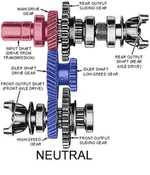Front Hubs & Towing
BusaDave9
Always Off-Roading Jeeper
- Posts
- 8,244
- Thanks
- 81
- Location
- Durango, Crawlarado
- Vehicle(s)
- 1979 Jeep CJ5 with 304 V8, T18 Transmission, Dana 20 Transfer case with TeraLow 3:1 gears, 4.88 axle gears, Detroit Locker up front and Ox Locker in back with 1 piece axle shafts, 36" SuperSwamper SX Tires, Shackle reversal, MileMarker Hydraulic winch, MSD 6A ignition.
I have always thought the front hubs should be unlocked when getting towed. This keeps the front axle and diff from rotating.
Then I got TeraLow gears for my transfer case and the instructions say when towing to put the transfer case in neutral and lock the front hubs. They underlined it for emphasis.
Of course the gear ratio in the T Case shouldn't make the difference. Does anyone know why it would be better to have the front hubs locked while towing?
Then I got TeraLow gears for my transfer case and the instructions say when towing to put the transfer case in neutral and lock the front hubs. They underlined it for emphasis.
Of course the gear ratio in the T Case shouldn't make the difference. Does anyone know why it would be better to have the front hubs locked while towing?






